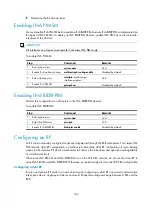
316
•
Determine the IP address of a static RP and the ACL rule defining the range of IPv6 multicast groups
to be served by the static RP.
•
Determine the C-RP priority and the ACL rule defining the range of IPv6 multicast groups to be
served by each C-RP.
•
Determine the legal C-RP address range and the ACL rule defining the range of IPv6 multicast
groups to be served.
•
Determine the C-RP-Adv interval.
•
Determine the C-RP timeout timer.
•
Determine the C-BSR priority.
•
Determine the hash mask length.
•
Determine the IPv6 ACL rule defining a legal BSR address range.
•
Determine the BS period.
•
Determine the BS timeout timer.
•
Determine the IPv6 ACL rule for register message filtering.
•
Determine the register suppression time.
•
Determine the register probe time.
•
Determine the IPv6 multicast traffic rate threshold, IPv6 ACL rule, and sequencing rule for initiating
an SPT switchover.
•
Determine the interval for checking the IPv6 multicast traffic rate threshold before initiating an SPT
switchover.
Enabling IPv6 PIM-SM
With IPv6 PIM-SM enabled, a router sends hello messages periodically to discover IPv6 PIM neighbors
and processes messages from the IPv6 PIM neighbors. When you deploy an IPv6 PIM-SM domain,
enable IPv6 PIM-SM on all non-border interfaces of the routers.
IMPORTANT:
All the interfaces on a device must be enabled with the same IPv6 PIM mode.
To enable IPv6 PIM-SM:
Step
Command
Remarks
1.
Enter system view.
system-view
N/A
2.
Enable IPv6 multicast routing.
multicast ipv6 routing-enable
Disabled by default.
3.
Enter interface view.
interface
interface-type
interface-number
N/A
4.
Enable IPv6 PIM-SM.
pim ipv6 sm
Disabled by default.
Configuring an RP
An RP can be manually configured or dynamically elected through the BSR mechanism. For a large IPv6
PIM network, static RP configuration is a tedious job. Generally, static RP configuration is just a backup
















































